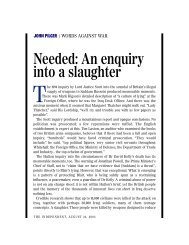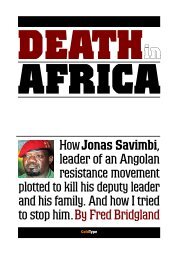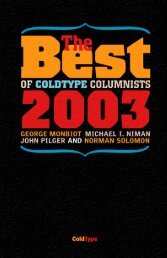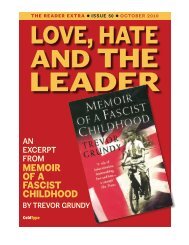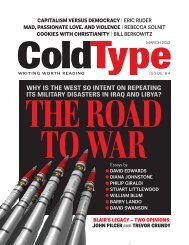UPDATED - ColdType
UPDATED - ColdType
UPDATED - ColdType
- TAGS
- updated
- coldtype
- coldtype.net
You also want an ePaper? Increase the reach of your titles
YUMPU automatically turns print PDFs into web optimized ePapers that Google loves.
cell door was closed and the click of its padlock<br />
confirmed that he would not be leaving his 6- by<br />
10-foot room that night. With each breath he made<br />
a sort of crying sound. Sometimes he broke that<br />
rhythm to exhale his pain with more force, and<br />
the otherwise silent block filled up with what I<br />
wondered might be the man’s last gasp.”<br />
U.S. mistreats reporters<br />
THIS tearful and horrific account was given lots<br />
of airtime on all the channels, as it should. An<br />
interview with non-embedded foreign journalists<br />
detained by U.S. military forces was aired on<br />
Amy Goodman’s Democracy Now yesterday, but<br />
not, as far as I know, picked up by any of the<br />
majors. It involved the experience of four socalled<br />
unilaterals. I reported on this last week.<br />
One of them was Dan Semama who describes<br />
meeting some U.S. soldiers who suspected they<br />
were spies. “They took away our cameras. They<br />
took away our ID cards. They took away our<br />
money. They took our phones. They put their<br />
guns towards us. They forced us to lie down on<br />
the floor. To take our shirts up to make sure we<br />
didn’t have any explosives on our bodies and<br />
were arrested.”<br />
At that point a Portuguese reporter asked the<br />
soldiers to phone home and tell his wife he was<br />
ok. Semama continues, “Five soldiers went out<br />
of the camp, jumped on him and started to beat<br />
him and to kick him. We ran to his direction.<br />
They all put bullets inside the cannons of their<br />
guns, and they said if we move forward they<br />
shoot at us. We were standing like stupid guys.<br />
We saw our friend lying on the ground crying,<br />
hurting. They tied his hand behind his back.<br />
They took him into the camp. And after half-an-<br />
SURROUNDING BAGHDAD<br />
159<br />
hour, they let him go, and came back to us all<br />
crying. And then came this Lieutenant Scholl.<br />
And he told us, ‘Don’t mess with my soldiers.<br />
Don’t mess with them because they are trained<br />
like dogs to kill. And they will kill you if you try<br />
again.” They were held for 36 hours.<br />
Reporting on the content<br />
of the coverage<br />
THE Project On Excellence in Journalism has<br />
issued a report on the embedded journalists.<br />
Here’s what they report: “The embedded coverage,<br />
the research found, is largely anecdotal. It’s<br />
both exciting and dull, combat focused, and<br />
mostly live and unedited. Much of it lacks context<br />
but it is usually rich in detail. It has all the<br />
virtues and vices of reporting only what you can<br />
see.”<br />
In an age when the press is often criticized for<br />
being too interpretive, the overwhelming majority<br />
of the embedded stories studied, 94 percent,<br />
were primarily factual in nature. Most of the<br />
embedded reports studied were live and<br />
unedited accounts. Viewers were hearing mostly<br />
from reporters, not directly from soldiers or<br />
other sources. In eight out of ten stories we<br />
heard from reporters only.<br />
This is battle coverage. Nearly half of the<br />
embedded reports (47 percent) described military<br />
action or the results. “While dramatic, the<br />
coverage is not graphic. Not a single story examined<br />
showed pictures of people being hit by fired<br />
weapons.<br />
“Over the course of reviewing the coverage,<br />
project analysts also developed a series of more<br />
subjective impressions of embedding. Often the<br />
best reports were those that were carefully writ-



